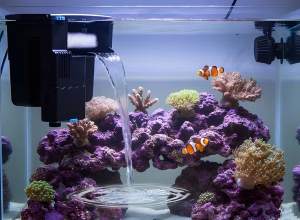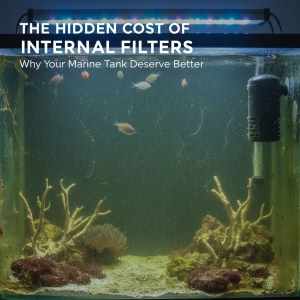How To Top Up Your Marine Aquarium’s Evaporation - And Why You should Do It
Welcome to Simple Reefs. We are a brand new website designed to take the stress and expense out of starting your very own marine aquarium. This week, we are talking all about Evaporation in your marine aquarium. We just looked at the causes of evaporation and prevention. Today, we are going to show you how to top up your marine aquarium’s evaporation and why you should do it.
As we talked about in our previous article, evaporation in a marine aquarium is guaranteed to happen. Our tanks create the perfect conditions for water to escape the surface. We heat our tanks to tropical levels, we agitate the water, we don’t use covers, and we have powerful lights over the surface. Evaporation is not just likely to happen, it is absolutely guaranteed.
Note: Please keep in mind that Simple Reefs is a very new website. Some information may be incomplete, some links may not be active, and some articles may be unfinished. Please bear with us while we build.
The Problems Caused by Evaporation
In our last article, we discussed the importance of stable levels of salinity to your aquarium’s residents. In summary, every animal in your tank is constantly maintaining a careful balance between the salt in their cells and the salt in their environment. This process is known as osmoregulation.
When salinity levels in your aquarium are within the desired range (click here for more information on what your marine aquarium’s salinity should be), this process is not a problem. After all, these creatures have evolved and adapted to survive in saltwater.
When your salinity levels are incorrect or when they swing rapidly, however, this process becomes a lot more difficult. The creature’s organs will have to work harder to maintain this delicate balance. This will result in their metabolism increasing, as a result. This can lead to stress, illness, and even death.
Evaporation Increases Your Water’s Salinity

We go in depth on the subject of stable salinity in our article on the importance of measuring salinity. Feel free to check that out to really learn about why stable salinity is so important to the health of your marine aquarium.
While there are many reasons for salinity swings in your marine aquarium, many of which we cover right here. Evaporation is one of the number one causes and it is something that many beginners don’t even realise will become a problem.
When the water evaporates from your tank, the minerals and salt are left behind. The only thing that leaves the tank is the water itself. This means the concentration of salt in the remaining water will now be higher, thus increasing your aquarium’s overall salinity. This can cause big problems, particularly if you aren’t checking your salinity frequently with a refractometer and aren’t topping up correctly.
It isn’t just your tank’s residents that can suffer as a result of evaporation, though. Your home and your health can too as we are about to discuss in an upcoming article. When it comes to your aquarium, you are going to want to make topping up evaporation a priority.
Why Should You Make Topping Up Evaporation a Priority?
Topping up your water level will keep your salinity levels stable. This will, in turn, help the creatures in your tank live a more comfortable and healthy life. Reducing stress is key to a thriving fish tank and maintaining stable levels of salinity is one of the easiest ways to keep stress levels low.
There is a bit of an underrated benefit to keeping your water levels topped up that you may not realise until it happens to you. Most of the equipment in our tanks is placed in such a way as to require a certain water level. Be it pumps, protein skimmers, gyres, or wavemakers.

When your water level drops, these various different pieces of equipment can suddenly fail to work as desired. A protein skimmer, for example, will begin to skim dryer as the water level drops. A gyre placed near the top of the water will start chopping up the surface water as it pulls in air. A pump for a reactor that is only slightly submerged may begin to dry out and overheat when the water level drops.
Topping up evaporation has benefits for both your tank’s residents and your equipment. There really is not good excuse not to do it. The good thing is, it is cheap and easy to top up evaporation. You can even automate the task to make your life even more simple.
Always Top Up With Fresh Water Not Salt Water
There is one key thing to remember when topping up evaporation in a marine aquarium. We always use freshwater to top up. Never use salt water for topping up evaporation. As we said earlier in this article, when water evaporates from your tank, the salt is left behind. The remaining salt becomes more concentrated in the water. That means we need to dilute the salt. We do this by simply adding more freshwater to the tank.
If we were to add more saltwater to the tank, we would actually be increasing the salinity. This is a very common beginner mistake. In fact, I talk all about when this very thing happened to a friend of mine in this Mishap Mondays article. Luckily, he was in the middle of cycling his new aquarium so the only consequences were a slightly delayed cycle. If you do this with a tank full of fish, you can cause major problems.

So all we need to top up our evaporation is freshwater. I would highly suggest using RO/DI water and not tap water. Tap water contains all sorts of minerals and chemicals that will cause big problems in your marine aquarium.
- Chlorine and Chloramines: Harmful to fish, beneficial bacteria, invertebrates and coral.
- Nitrates and Phosphates: Nutrients that will cause nuisance algae growth.
- Silicates: Can contribute to diatom blooms.
- Heavy Metals: Extremely toxic to marine life.
- Undesirable Minerals: Minerals vary by water source but can accumulate over time and alter your water chemistry in unpredictable ways.
Chlorine in the water, for instance, will quickly accumulate and gradually poison everything in your tank. Tap water also contributes heavily to the growth of algae thanks to unwanted nutrients. Tap water can contain things like silica which will encourage the growth of those dusty brown algae known as Diatoms which use it to build their shells. It can also contain other unwanted elements including nitrates, phosphates, and even heavy metals like copper.
A RO/DI filter can be purchased for very little money and will purify your tap water to a very low level of contamination.
You can also purchase RO/DI water from fish shops or, even, the car section of your local supermarket. A couple of litres of Deionised water costs only a pound or two. A RO/Di filter will be the cheapest and most convenient option in the long term, though.
Topping Up Evaporation Manually
This is the traditional way of doing things. I am going to be honest, however. If you have a lot of tanks or you have a decently sized aquarium, this is going to get annoying fast. Most aquariums with limited cover will require topping up very frequently.

My Red Sea Reefer 425XL loses a few litres of water every day when uncovered. If it begins to become an annoying chore, you may want to move onto our next method. Either way, I am going to make a few suggestions to make your life a bit easier. Let’s take a look.
Mark Your Normal Water Level: Sounds simple but a lot of people don’t do this. Take a piece of tape, a sharpie, or a label from a label maker, and mark your regular water level. This is the level that your water should be ideally. This way, you will have a visual reference point for when your water level has dropped. When you are topping up your evaporation, just top it back up to this mark. That way, your salinity will stay as stable as possible as you won’t be topping off too much water.If you have a sump, you may want to mark the level that your water is at when the return pump is switched off, as well. This will allow you to be sure that you are filling up to the correct level when performing water changes.
- Keep a Supply of RO/DI Water in a Dedicated Container: Keep your RO/DI water in a suitable, food safe, container ready for topping off your evaporation. You really don’t want to be caught out needing to top up without water ready to go. You also don’t want to mix saltwater jugs with freshwater as they may contain residue. If you are going to be pouring the freshwater into your tank using a jug, make sure the jug is also food safe and keep it specifically for topping up and nothing else.
- Add Your Water Slowly: This is the really frustrating part about topping off manually. You don’t want to shock your tank’s residents by dumping in a load of cold water all at once. You want to add the water slowly. Now, some people suggest topping up gradually over the course of a day. That’s a bit ridiculous, in my opinion. These same people also tend to use Automatic Top Off systems which most definitely don’t work like this and usually add a bulk amount of water when the level drops to a certain point. You just need a slow, steady, stream of water. Think about it like running a tap on the lowest pressure. Just trickle the water in gradually over a few minutes. Don’t just tip the jug up haphazardly. Even better, create a siphon using a small length of hose and let it do its thing for a bit. Just be sure to keep an eye on the level.
- Where To Add The Water: If you have a sump, top up in the sump. If you have an ATO, top off in the back chamber. If you are using hang on back equipment, top up near the flow from the filter as this should help mix the freshwater in. Either way, you want to be trying to avoid disrupting the things in your aquarium too much.
The traditional methods always work but you have to be diligent about monitoring your salinity level. Manually topping off your evaporation may need to be done daily and may become a bit of a chore. If this sounds like it will bug you or you will forget, why not automate the process?
Topping Up Evaporation Automatically
An Auto Top Off (ATO) can really simplify the task of topping up evaporation. In fact, it takes all of the fuss right out of the process. An ATO will detect when the water level drops and then slowly add freshwater to the tank over the course of ten minutes or so. This will mean you don’t have to do any extra work and you will be maintaining a high level of stability in your tank.
The way Auto Top Off devices work is via the combination of a sensor to detect the current water level and a pump to move freshwater from a container and into the tank using a series of hoses.
The sensors are typically of the ‘float’ or ‘optical’ variety. A float is an old fashioned manual style device that will drop when there is no water present, indicating a drop in the water level, or float when there is water present indicating the water level is sufficient. An optical sensor often uses an infrared beam that is broken when the water level is fine and open when the level drops indicating the level is too low.

The idea is, when the sensor detects that the water has dropped beyond a certain level, the sensor will send a signal to the water pump to activate. The water pump will then switch on and transfer water from a container filled with RO/DI water slowly into the tank itself.
These automatic top off systems usually come with a bunch of redundancies to make them safer. After all, you wouldn’t want them just adding water continuously until your tank overflows. For example, mine has a sensor for the normal water level, a sensor for the level being too high, and a sensor for the level being too low.
If the water level is too high, the ATO will switch off and sound an alarm to ensure it doesn’t overfill the tank. If the level is normal, it does nothing. If the water level is too low, it will switch on and run for up to ten minutes. If the water level doesn’t normalise within ten minutes, it will sound an alarm to avoid overfilling it in case the sensor has malfunctioned.
How To Use an ATO
ATOs come in all kinds of shapes and sizes so it is difficult to create one concrete set of instructions. They simply work by following the included instructions but they all tend to be used in a similar way.
- Prepare your freshwater Reservoir: Add RO/DI water to a reservoir and place the ATO’s pump into the reservoir with hose.
- Position your top up hose: The other end of the hose will then be placed in the area of your tank or sump that you want to be topped up. Usually the centre chamber on a sump, the return chamber on an AIO tank, or near the filter on a standard tank.
- Position Your Sensor: You will then take the sensor that came with your ATO and place it in your tank or sump to correspond with your desired water level. In a tank with a sump, you place the sensor in the same part of your sump as your return pump. This is the chamber that a change in water level will be noticeable in. In an AIO tank, the sensor typically goes in the final chamber where your return pump is. In a standard tank, it will have to go in the main display. Keep the sensor away from things like wave makers and gyres. The water movement will throw things off and water levels near these kinds of devices will probably be a bit lower. You also don’t want bubbles hitting the sensor as this can throw off the reading.
- Plug Everything in And Switch Everything On: Your ATO will probably have a series of connections or plugs to connect the pump to the sensor etc., so go ahead and do that. You can then go ahead and plug it into power and keep a close eye to make sure it is all working correctly.
ATO’s make life a hell of a lot easier but you do need to be cautious. You will want to clean out your RO/DI water reservoir every now and then and you will need to frequently clean your sensor.

Salt creep can throw the readings off or jam up the float which will cause them to over or under fill. It’s a good idea to clean your ATO’s pump, too.
You also need to remember to top up your reservoir when it runs dry. Most ATO’s have no idea whether there is any water in the RO/DI reservoir so the pump will keep running even if there is no water for it to pump. This can cause them to burn out due to overheating.
ATOs can be quite expensive. Some start fairly reasonable but they can go way over £100 so keep that in mind. It is a big time trouble saver but it costs a lot of money. Older devices can be prone to failure, as well, so maintenance is important.
In Short
Topping up evaporation in your marine aquarium is incredibly important to the health of your tank’s residents. You should always top up with fresh water and never with salt water. You may want to mark your tank’s normal water level so you always have a visual reference for when you need to top up. Auto Top Offs (ATOs) can take all the hassle out of topping up but are quite expensive. Thanks for reading and spending your time at Simple Reefs.








